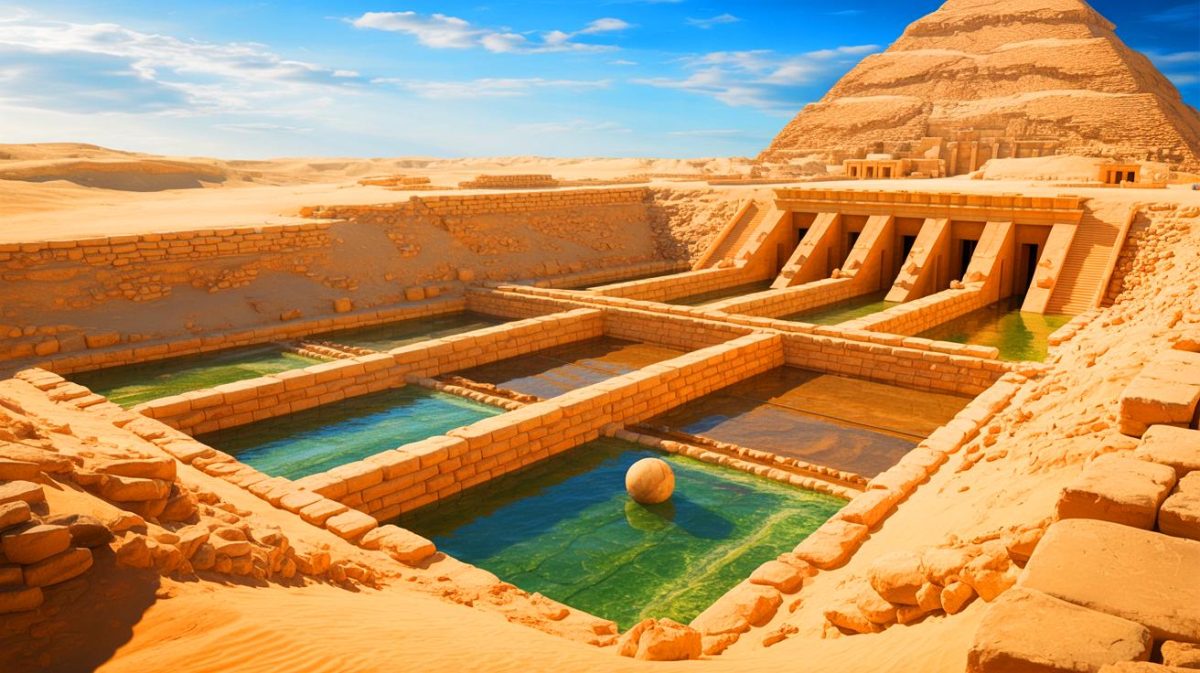| IN A NUTSHELL |
|
In the silent and scorching expanses of Egypt’s desert, a groundbreaking discovery has emerged, poised to rewrite our understanding of ancient engineering marvels. Located around the Pyramid of Djoser, researchers have uncovered a remarkably advanced water management system. This revelation challenges long-held theories about the architectural feats achieved by the Old Kingdom builders. The system, comprising an intricate network of structures, indicates a sophisticated grasp of hydraulic engineering by ancient Egyptians. Such findings compel historians and archaeologists to reconsider the technological prowess of this ancient civilization, sparking fresh debates over their innovative capabilities and problem-solving skills.
Ingenious Stone Dam Capturing Desert Floodwaters
The enigmatic Gisr el-Mudir, nestled in Saqqara, has long baffled researchers due to its grand scale and unclear purpose. Measuring nearly 1,180 feet in length, it stands among Egypt’s oldest constructions. Recent investigations led by Xavier Landreau and his team from the CEA Paleotechnic Institute, as published in PLOS ONE, have cast new light on this stone enclosure. The structure is now interpreted as a dam, ingeniously capturing seasonal floodwaters from surrounding wadis, challenging earlier beliefs of it being a ceremonial or defensive site.
By meticulously analyzing natural features such as slopes and erosion patterns, researchers have reconstructed a watershed capable of channeling water into this enclosure. This stone dam had the capacity to contain up to 14 million cubic feet of water, supporting extensive construction endeavors. Additionally, seasonal floods would deposit sediments downstream, naturally enhancing the site’s utility. This discovery suggests that Saqqara’s location was strategically selected for its geological and hydrological benefits, alongside its religious and political significance.
How Hydraulic Construction of Pyramids Worked
While securing a substantial water supply was crucial, it alone could not elevate the colossal limestone blocks necessary for pyramid construction. The secret, it seems, lay beneath the Djoser complex. A vast trench, previously considered symbolic, revealed a series of interconnected basins and compartments. Termed the “Deep Trench,” this system functioned as a water treatment facility, purifying water by allowing sedimentation of heavier particles.
This clarified water likely powered a vertical lifting mechanism beneath the pyramid. Two vertical shafts, linked by an elongated underground gallery, potentially enabled a flotation device. Blocks placed on a floating platform would ascend through water pressure injected into the shafts. Upon reaching a sufficient height, the load could be transitioned onto the monument’s upper tiers. The observed structures in the galleries and compartments bolster this hypothesis, suggesting a system akin to a hydraulic elevator that leveraged water’s force to minimize mechanical exertion.
Sophisticated Technology Matching Pharaohs’ Ambitions
The hypothesis of hydraulic construction is bolstered by significant evidence found at the site. The dam, basins, galleries, and shafts form a coherent organization consistent with a hydraulic chain. Contrary to popular belief, ancient Egyptians had already mastered numerous water-related techniques. Their proficiency in irrigation, wooden gates, and agricultural dams highlights a well-established hydraulic knowledge. This study underscores how such a system could reduce the necessity for extensive ramps, significantly decreasing labor demands and logistical challenges.
This advanced level of engineering prompts a reevaluation of other Old Kingdom monuments. The Pyramid of Djoser, often regarded as a prototype, might represent the zenith of a developed technology that subsequent dynasties could not replicate. This revelation challenges the conventional narrative of pyramid construction, suggesting a fusion of clever engineering and resourceful adaptation to environmental challenges.
How Saqqara’s Hydraulic Remains Alter Our Historical Perspective
Previously, pyramids were primarily examined for their symbolic or architectural significance. The discovery of a comprehensive hydraulic system opens new avenues for exploration. It indicates that the builders were not solely executing a religious project but were also crafting a sustainable technical ecosystem, well-suited to the environment and available resources.
This multidisciplinary approach, combining archaeology, hydrology, and geotechnics, enriches our understanding of the past. It reveals sophisticated work organization, rigorous material management, and nuanced exploitation of the territory. The pyramids now appear not only as the result of massive labor mobilization but also as products of an underestimated technical genius. This new perspective invites us to reassess other monumental sites, searching for similar traces of forgotten hydraulic systems.
As we continue to delve into the sands of Egypt, new discoveries may yet further challenge our understanding of ancient ingenuity. What other technological marvels lie buried, waiting to alter our perceptions of history once more?






This discovery is mind-blowing! 😮 How did they keep this under wraps for so long?